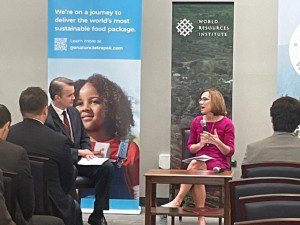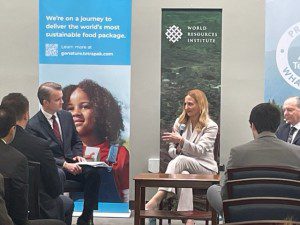News and Insights
Reaping What We Sow: Creating Resilient, Global Food Systems to Feed People Without Harming the Planet
June 6, 2023
On its face, feeding the world’s nearly 8 billion people (which the United Nations projects will grow by another 2 billion in the next 30 years) should be as simple as “grow more food.” But if there was ever an example of how the simplest of tasks can be the hardest to achieve, this is one of them.
That’s because ensuring sustainable food security for all requires managing complex, interconnected factors like agricultural productivity, climate change, resource management, and equitable distribution of food.
In short, how do we balance the nutritional needs to keep people healthy without creating biodiversity and climate risks that will jeopardize a healthy planet?
 A recent Capitol Hill symposium in Washington, D.C. convened by Tetra Pak, World Resources Institute (WRI), and the Embassy of Sweden, took a closer look at what a stable food future will require and how industry, government, and civil societies can work together to support the innovation needed to create resilient, global food systems.
A recent Capitol Hill symposium in Washington, D.C. convened by Tetra Pak, World Resources Institute (WRI), and the Embassy of Sweden, took a closer look at what a stable food future will require and how industry, government, and civil societies can work together to support the innovation needed to create resilient, global food systems.
The discussion reinforced the challenges—and potential solutions—that we all must reckon with.
Addressing Food Waste
Ironically, what’s in short supply is not always valued. According to Feeding America, “each year, 119 billion pounds of food is wasted in the United States. That equates to 130 billion meals and more than $408 billion in food thrown away each year. Shockingly, nearly 40% of all food in America is wasted.”
Food waste comes in many forms:
- On-farm waste from rotting or unharvested crops
- Commercial waste postharvest from inefficient processing, packaging, or distribution practices
- At-home waste due to spoilage or simply uneaten food that gets thrown out
Institutional food waste associated with the cold supply chain (foods that have to be refrigerated from farm to table) is also significant. Consider the issue of school milk. A study by the World Wildlife Fund (WWF), found that food waste at U.S. schools could be as much as $1.7 billion every school year. Of that, WWF’s study of 46 schools found that approximately 29 cartons of milk waste were created by each student annually.
What’s troubling is not just the loss of food that could have otherwise fed people. The problem of food waste is exacerbated because of its impact on the climate once it is landfilled. In 2021, the U.S. Environmental Protection Agency (EPA) published a report on the environmental impacts of food waste. Notably, it found that each year, U.S. food loss and waste is equivalent to 170 million metric tons of carbon dioxide (million MTCO2e) GHG emissions). That’s equal to the annual CO2 emissions of 42 coal-fired power plants!
Managing Land Use
Most of the earth’s surface is water—the U.S. Geological Survey puts it at about 70 percent. The land that remains must be used carefully. Certainly, the food supply depends on farmland and grazing lands. But other lands are equally important. Forests provide habitats for species and absorb CO2. Tropical rainforests, like the Amazon Rainforest, are living libraries of life sciences and have been instrumental in supplying the “answers” necessary to preserve and protect global human health. Unfortunately, conversion of natural ecosystems and forest lands for agriculture use is happening at a rapid pace. A review in the journal Science estimated the annual global conversion of tropical forests at the equivalent of more than 8 million soccer fields.
Decarbonizing Dairy
As pointed out in the Capitol Hill Symposium by the Global Dairy Platform, dairy is the world’s largest agricultural commodity by value, third largest by volume, and a big emitter of greenhouse gases—about 2 percent of emissions globally.
But 6 billion people regularly consume dairy as part of a healthy diet. Furthermore, this is an industry that creates 240 million jobs, 80 million of which are held by are women. The livelihoods of another 400 million depend upon the dairy sector. Milk, especially milk in school feeding programs, is vital to fighting childhood hunger in many communities in the U.S. and across the world.
These are economic and social realities that must be considered. As Global Dairy Platform’s Executive Director Donald Moore says, we can’t solve for climate change by creating a crisis in nutrition or the economy.
Here and Now Solutions
 While data and the prospects for the planet are foreboding, we are not without a path forward that can help balance the planet’s needs with the needs of her people. Some of these solutions were put forth at the symposium. For example:
While data and the prospects for the planet are foreboding, we are not without a path forward that can help balance the planet’s needs with the needs of her people. Some of these solutions were put forth at the symposium. For example:
- Maximize land use and, as WRI’s Tim Searchinger pointed out, hold down demand. This means producing more food on the same land instead of stressing available land to also create nonfood products like biofuels.
- Agriculture and dairy farmers must have a seat at the table when regulatory or incentive policies are under discussion, and there needs to be an understanding that the size and scale of farms differ vastly. “One-size-fits-all” incentives or other solutions may not always work. That being said, farmers, especially dairy farmers, require access to finance to modernize their technologies, scale their outputs, and adopt climate-smart practices. For that, industry and government need to support them , especially to meet the necessary pace of change.
- Finally, the issue of food waste and food security can be alleviated by deploying technologies that both extend food’s shelf life and protect natural resources. Shelf stable packaging allows consumers to keep unopened food in the pantry for upwards of a year and eliminates the need for refrigerated transport or storage of these food products. Tetra Pak’s President and CEO Seth Teply shared that the company is decarbonizing the materials they use and maximizing the use of renewable materials within its packages while also decarbonizing its production processes by switching to renewable energy.
Ensuring resilient food systems and food security is integral to mitigation efforts as the planet warms. If we look at the issue holistically—through the lens of science, innovation, and equitable policies—we can meet the nutritional needs of a growing population while preserving our planet’s resources for future generations.